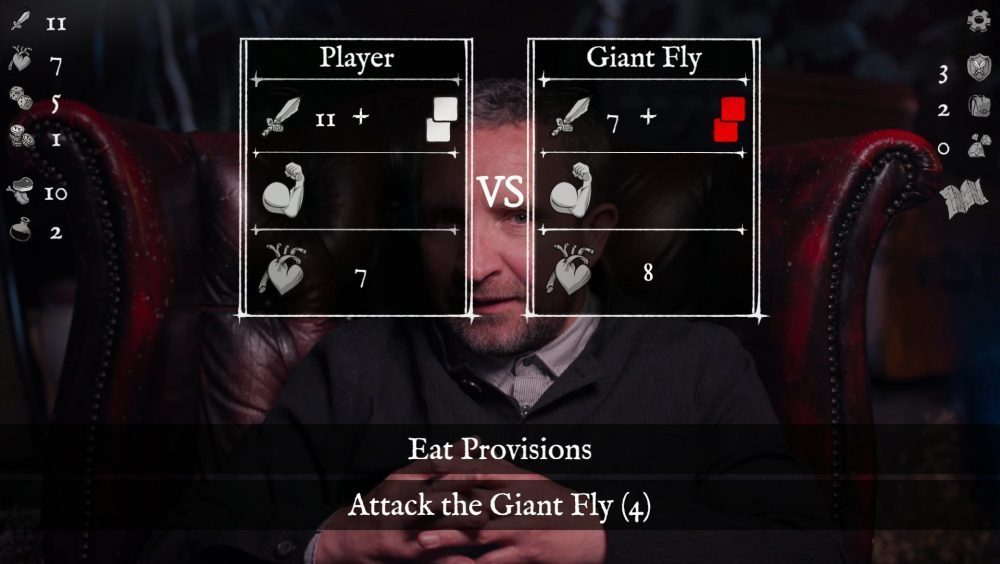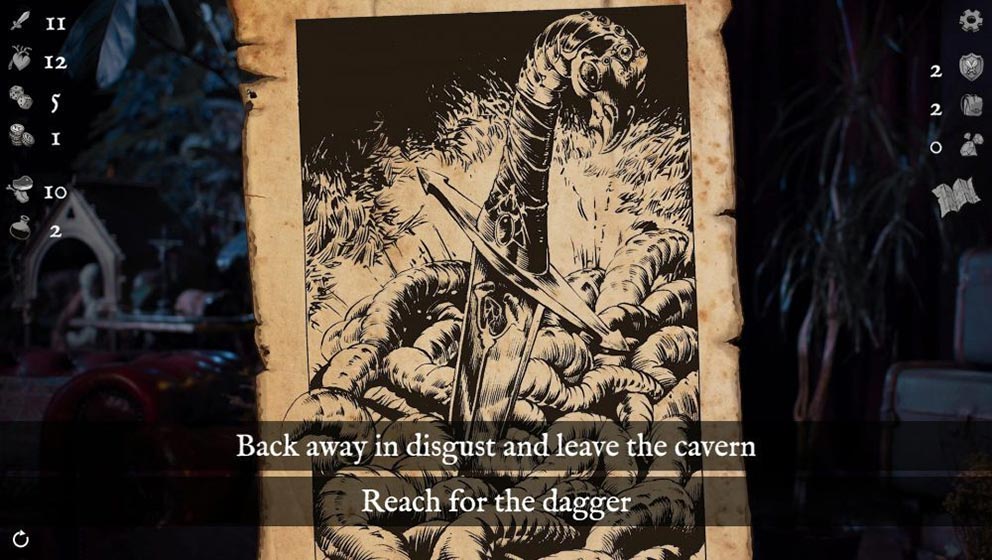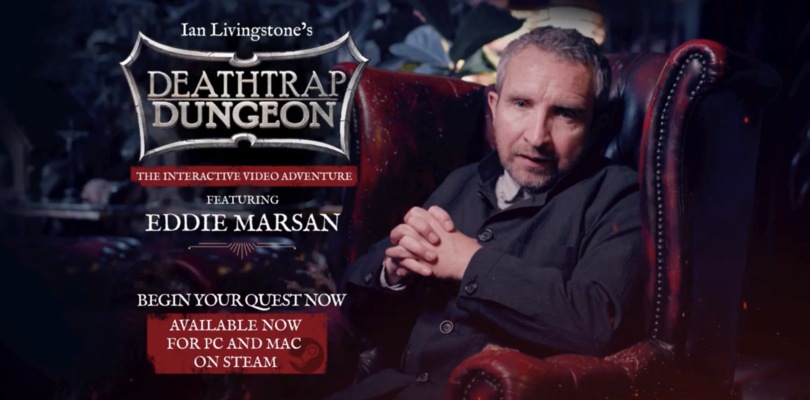In 1984, Puffin Books released a “Choose Your Own Adventure”-like book called Deathtrap Dungeon, written by Games Workshop co-founder Ian Livingstone. By the way, if Games Workshop sounds familiar but you don’t know why, they created several tabletop miniature wargames, most notably Warhammer and Warhammer 40,000, upon which countless books and video games have been based.
Deathtrap Dungeon was the sixth book of its kind in a series called Fighting Fantasy. The book puts you in the shoes of an adventurer who attempts to navigate a monster- and trap-filled underground labyrinth constructed years ago by Baron Sukumvit. Conquering the labyrinth is an annual contest known as the Trial of Champions. Of course, until now, nobody who has entered the labyrinth has defeated it. In fact, nobody who has entered the labyrinth has ever been seen again. Your character and five others enter the labyrinth one at a time at 30-minute intervals, and, much like the fantasy monsters and fiendish traps you encounter, the other challengers will likely play parts in your adventure, depending on the choices you make as you read.
The book has already been adapted as a video game twice. In 1998, Asylum Games developed a third-person action version of the title, which was published by Eidos Interactive (now Square Enix) and released for PS1 and Windows (currently available on Steam) under the title Deathtrap Dungeon. Additionally, Nomad Games developed and published a more faithful gamebook adaptation as part of their Deathtrap Dungeon Trilogy in 2018, which bundled three books from the series into one title.
Whew.
Recently, Branching Narrative Ltd. decided to take another swing at adapting the book for gamers. They opted to do a version of the book as faithful to the source material experience as is humanly possible. Simply reading onscreen text and picking the occasional choice on your screen may sound more like reading an ebook, so their challenge was to find a way to engage readers while maintaining an emphasis on the detail-navigated fantasy narrative that Livingstone originally published over 35 years ago.
They rose to that challenge with the aid of British actor Eddie Marsan.

Marsan is best known to American audiences for his performances in television’s Ray Donovan, the Guy Ritchie-directed Sherlock Holmes films, Deadpool 2 and The World’s End, the third part in Edgar Wright’s “Cornetto Trilogy.” He also recently appeared in Fast and Furious Presents Hobbs and Shaw and co-starred in 21 Grams and Snow White and the Huntsman. In 2020’s Deathtrap Dungeon: The Interactive Video Adventure (which will, for purposes of clarity, be known as Deathtrap Dungeon 2020 from here on out), he serves as something of a cross between host, narrator and dungeon master, guiding you from one branching pathway to another with aplomb and detailing your conquests as you fight hobgoblins, orcs, giant scorpions and other monsters. Marsan is with you literally every step of the way, from explaining the game’s battle system to successfully triumphing over Baron Sukumvit’s cruel maze.
How the game plays is best explained through its presentation. For 95% of the game, players see Eddie Marsan, filmed in glorious high-definition and filling your screen. He sits in a plush leather chair in a strange room that looks a bit like an old explorer’s office being overgrown by forest. A fire crackles offscreen, lending a yellow-orange tint to the otherwise dimly-lit, blue-saturated evening atmosphere. Imagine you were in an old mansion and a tornado lifted it off to a desert island. You wake up in a bright moonlit evening and the roof is gone but whatever else of the room that didn’t land sideways in the jungle portion of the island remains. And in a dark red, high-backed leather chair, Eddie Marsan tests your decision-making skills and luck for several hours to determine if you get to go home or if he snaps a finger and disappears, leaving you to stay on the island forever.
For the remaining 5% of the game, a simple dice-based battle system determines your fate against monstrous foes. In the beginning of the game, you roll for skill (strength), stamina (health) and luck (luck). Your enemies have base stats as you encounter them as well, and you and they each roll two die per turn. The base stat plus the value of the die determines who wins the skill or luck roll, usually removing one or two points from the other’s stamina. Before each turn, you have the option to attack the creature outright or eat provisions first, restoring some stamina points. As the die appear and show your results, Marsan narrates a brief line about the turn.
Additionally, classic artwork from the original gamebook sometimes appears, covering the screen and lending visualization to Marsan’s descriptions of the environments and creatures of the story. It’s a nice touch that should please readers of the original book; it also helps change the pace of the usual presentation, which – while terrific – could run the risk of seeming homogeneous or monotonous otherwise.

Since Deathtrap Dungeon the book largely hinges on its narrative, so too does the success of Deathtrap Dungeon 2020. Branching Narrative Ltd. took an enormous gamble developing and funding a game that cynics could call “having someone read a Choose Your Own Adventure book to you.” This view, while myopic and reductive, would certainly get its point across. However, the safest part of the bet that Branching Narrative took is in choosing their host – and in Eddie Marsan, they have chosen very, very wisely.
Marsan has such a natural cohesion with the text, it’s not just hard to believe he didn’t write the book himself – at times it’s hard to believe he’s even narrating an experience that’s been previously written at all. The story seems to be visually unfolding in his head more than being recited from memory. Flickers of genuine excitement flash behind his eyes as he describes the crash of a morningstar against a sturdy shield; impish mischief lights up his face as he talks about a cunning dwarf proposing a game of dangerous tricks to your character. His acting performance throughout the title drips with emotion but is carefully restrained enough to get the point across with every sentence. He’s so incessantly enthralling it’s difficult to look away.
Side note: Personally I’m in favor of professional actors in video games, including lending their likenesses. I think it worked for Ellen Page and Willem Dafoe in Beyond: Two Souls, it was good for Hayden Panettiere and Rami Malek in Until Dawn and the cast of Death Stranding did excellently last year as well. Nailing down a famous person’s voice and/or likeness is still a recent enough phenomenon (my earliest example off-hand being David Bowie in Omikron: The Nomad Soul) that there’s a bit of a novelty to it, but in my opinion, casting them in a game is less of a selling point than, say, a kids’ movie, at which I constantly find myself playing “Guess the Celebrity” rather than focusing on the script. In Deathtrap Dungeon 2020, Eddie Marsan is really doing a job: he’s working to bring you into the world of the game and to tell you a story.
The reason I spend so much time on this is because of what a major component of the game it is and to make sure that I properly stress that it isn’t a gimmick. This isn’t one of the Kim Kardashian iPhone games; it comes across as a real labor of love by all involved. Cool? Cool.

Your first several times through the game – yeah, you read that right – you’ll likely survive a couple hours or less. I saw a YouTube video showing someone making the wrong choice and dying at a trap I encountered about 30 minutes in. But unlike a “replayable” title that requires 100+ hours per playthrough, Deathtrap Dungeon 2020 is the type of game you’ll easily want to give another go when – not if – you meet your untimely demise. Choose different paths through the labyrinth, make different decisions, get different treasures and weapons, suffer a different fate.
So, aside from the overall tremendously enjoyable experience, there are a couple missteps. First, there’s no manual save option and the autosave isn’t presented clearly. When I booted up the game the first time to take a quick peek, I was 45 minutes in before I had to just pause and quit since I couldn’t find the save button and I didn’t see anything about autosaves (hint: when you get to a new area where Eddie Marsan details some new room or encounter, the beginning of that new narration is usually where it autosaves). I worried that I’d have to start over from the beginning, but the next time I came back, I found that the game auto-loaded to a point just four or five minutes before where I had quit. It was a relief that I’d barely lost any progress, but I feel like in this day and age it could have been made more clear from the beginning. I know we all skip over those lame-ass screens at the beginnings of games that say “When this stupid little animated icon is on your screen, the game is autosaving, so don’t turn off your console like some kind of goddamned preschooler,” but I think that subconsciously we’re glad those screens are there. Anyway, it threw me, and it does remind you of how straightforward – if not a bit bare-bones – the title is.
Secondly – and there’s not really a way for this to be done any better so it’s not a complaint against the title as much as the genre – some of the camera cuts can get pretty jarring. “Camera cuts?” I hear you ask. What, you thought they had Eddie Marsan do the whole game in one take, just 1,000 different ways? No; that would be as impossible as it would be insane. As a human being and not a smashy smashy eggman, Marsan couldn’t perform the book once for each choice you could make (for up to five hours at a stretch). So naturally it’s filmed in scenes, which is perfectly fine, but occasionally (maybe a few times per hour), it can feel like a bit of a jump cut. When you choose route A versus route B, both of which can end up at destination X, occasionally you can tell that the dialogue for destination X wasn’t filmed as a continuation of route A (or route B) – like, they didn’t just switch cameras; it’s a different take. In the same vein, there are only so many ways to describe a successful hit on an enemy, so if you manage to find enough trouble throughout the game, you may recognize a couple sentence-long passages being repeated here and there. There’s one shot with a line like, “Your enemy howls in pain as your sword slashes its leg” that I heard fighting different enemies, for example.

However, I’d say this grievance is a necessary evil – a price we all pay for the format the game uses rather than the animation transitions characters use in more standard/CGI-based video games. I also want to note that in this instance, I’m spending so much time explaining this issue NOT because it’s a major one but simply because it’s harder to put into words than issues with which we’re all familiar in other games (like “glitchy,” “framerate drops,” “clunky controls,” etc).
The best way to summarize Deathtrap Dungeon 2020 is, as I giddily explained to my wife the other night, that it’s like playing a single-player D&D campaign with none of the hassle and with a recognizable and incredibly engaging famous actor as your dungeon master. Having Eddie Marsan fold his hands together in front of his face and proudly tell you you’ve seen through a character’s tricks and traps – or describe in urgency how you narrowly escape a drowning death in a flooding room – is as rewarding as it gets. Like the scene in Indiana Jones and the Last Crusade in which the knight says “You’ve chosen…wisely,” it’s immensely gratifying; the experience in all is, simply, incredible fun. Dungeon-based fantasy adventure gaming – delivered with award-worthy performance by a charming actor – far outweighs the current technical shortcomings of the title. It’s also priced right at about $12. For these reasons, I’m rating Deathtrap Dungeon: The Interactive Video Adventure an 8 out of 10.
AIR Entertainment was provided a free copy of this game on PC for review.
